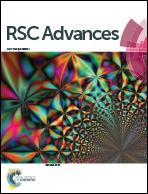Hydrogenated hematite nanostructures for high-efficiency solar water oxidation†
Abstract
Hydrogenated hematite has been prepared and the effect of oxygen vacancies has been investigated. An obvious cathodic shift (up to 120 mV) of the onset potential can be observed after hydrogenation treatment, revealing the interesting role of oxygen vacancies in hematite to lower the onset potential in contrast to that leading to high onset potential in the literature. The results suggest that the high onset potential should be attributed to the low temperature treatment. The optimized hematite with oxygen vacancies exhibits a high photocurrent of 2.12 mA cm−2 at 1.23 V vs. RHE and a relatively low onset potential around 0.8 V vs. RHE. It can be further coupled with a Co–Pi catalyst, P-doping or FeNiOx catalyst to achieve a high photocurrent of 2.6 mA cm−2 at 1.23 V vs. RHE and a low onset potential of 0.62 V vs. RHE. Significantly, the hematite modified with both P-doping and a FeNiOx catalyst can show a synergetic effect to yield a photocurrent of 2.00 mA cm−2 at a low bias of 1.0 V vs. RHE, which is among the best values reported. The benefits of facile, low-cost preparation, and high performance promise the hydrogenated hematite to be an excellent precursor material for further modifications for solar water splitting applications.


 Please wait while we load your content...
Please wait while we load your content...